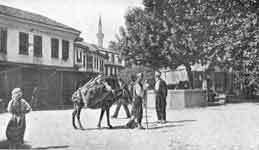.


Administrative Region : East Macedonia and Thrace
Regional unit : Drama
Drama (Greek: Δράμα [ˈðrama]), the ancient Drabescus (Greek: Δράβησκος), is a town and municipality in northeastern Greece. Drama is the capital of the peripheral unit of Drama which is part of the East Macedonia and Thrace periphery. The town (pop. 42,501 in 2001) is the economic center of the municipality (pop. 55,632), which in turn comprises 53.5 percent of the prefecture's population. The next largest communities in the municipality are Choristi (pop. 2,625), Χiropótamos (2,601), Kalós Agrós (1,216), Kallífytos (1,083), and Koudoúnia (885).
Name
Drama has excellent water resources and may well owe its name to Hydrama (Greek: "having to do with water"), a town which it is believed stood on the same site in ancient times. In the Roman era, Drabescus was a trade center and military camp on the Via Egnatia. Since the Middle Ages it has been known as Δράμα in Greek and Драма in Bulgarian.
History
Part of the town's Byzantine walls.
In 1912 during the First Balkan War, Drama was taken from the Ottomans by Bulgarian troops. Subsequently, in 1913 as a result of the Treaty of Bucharest, following the Second Balkan War, it was incorporated into Greece along with the rest of Eastern Macedonia and Western Thrace.
Drama was occupied by Bulgarian troops from 1941 to 1944 during World War II.
The Drama uprising and the Drama massacre
Main articles: Axis occupation of Greece during World War II#The Drama uprising and Doxato#History (Doxato Massacres)
On September 29, 1941, in response to local communist guerrilla attacks against the Bulgarians in the villages of Drama, the Bulgarian occupation forces applied harsh reprisals in Drama, Doxato and several villages like Choristi, Kyrgia, Koudounia and Prosotsani.[2]
The deportation of Drama's Jews
The Holocaust memorial.
On March 4, 1943 after midnight, there was an action all over Thrace, including in the city of Drama. Bulgarian soldiers led by foot and freight trains all the 4,000 Jews in Thrace, including the 589 from Drama, into Bulgarian territory and assembled them in the tobacco warehouses that were empty this time of year. From there, the Jews were taken by train to the extermination camp of Treblinka. No one of the 589 Jews from Drama came back.[3][4]
Economy
Old mansion in Drama.
The church of St.Panteleimon.
The springs of Agia Varvara.
In the recent past the economy of the Drama area relied heavily on the local paper and textile-clothing industries. However, these industries have either closed down or moved across the border to Bulgaria,[5] because of the low demands of the Bulgarian workforce,[6] with a negative impact on the local economy and employment. The situation worsened after 2007, when Bulgaria was admitted to the EU, and local Greek businessmen moved to expand their operations there. Other sources of revenue include agriculture, consisting mainly of tobacco plantations, small-scale mining (particularly of marble) and forestry. Recently, there have been efforts to exploit the rich local natural environment and to develop ecotourism.
There is a modern ski resort on Mount Falakro. Drama also hosts an annual short film festival[2].
Municipality
Division of the former municipality
- Drama / Δ.δ. Δράμας [ 43485 ]
- Drama / η Δράμα [ 42501 ]
- Ampelakia / τα Αμπελάκια [ 335 ]
- Nea Sevasteia / η Νέα Σεβάστεια [ 480 ]
- Taxiarchai / οι Ταξιάρχαι [ 169 ]
- Drama / η Δράμα [ 42501 ]
- Kallifytos / Δ.δ. Καλλιφύτου [ 1149 ]
- Kallifytos / η Καλλίφυτος [ 1083 ]
- Panorama / το Πανόραμα [ 66 ]
- Kallifytos / η Καλλίφυτος [ 1083 ]
- Kalos Agros / Δ.δ. Καλού Αγρού -- ο Καλός Αγρός [ 1216 ]
- Koudounia / Δ.δ. Κουδουνίων -- τα Κουδούνια [ 885 ]
- Livaderon / Δ.δ. Λιβαδερού [ 146 ]
- Makryplagion / Δ.δ. Μακρυπλαγίου [ 84 ]
- Makryplagion / το Μακρυπλάγιον [ 74 ]
- Polykarpos / ο Πολύκαρπος [ 10 ]
- Makryplagion / το Μακρυπλάγιον [ 74 ]
- Mavrovatos / Δ.δ. Μαυροβάτου -- ο Μαυρόβατος [ 714 ]
- Mikrochorion / Δ.δ. Μικροχωρίου -- το Μικροχώριον [ 598 ]
- Monastirakion / Δ.δ. Μοναστηρακίου [ 866 ]
- Monastirakion / το Μοναστηράκιον [ 781 ]
- Vathylakkos / ο Βαθύλακκος [ 85 ]
- Monastirakion / το Μοναστηράκιον [ 781 ]
- Mylopotamos / Δ.δ. Μυλοποτάμου -- ο Μυλοπόταμος [ 778 ]
- Nikotsaras / Δ.δ. Νικοτσάρας ( πρώην κοινότητας Αργυρουπόλεως) -- ο Νικοτσάρας [ 309 ]
- Xiropotamos / Δ.δ. Ξηροποτάμου [ 2777 ]
- Xiropotamos / ο Ξηροπόταμος [ 2601 ]
- Metamorfosis Sotiros / η Μεταμόρφωσις Σωτήρος [ 176 ]
- Xiropotamos / ο Ξηροπόταμος [ 2601 ]
- Choristi / Δ.δ. Χωριστής -- η Χωριστή [ 2.625 ]
The new municipality Drama was formed at the 2011 local government reform by the merger of the following 2 former municipalities,
Drama
Sidironero
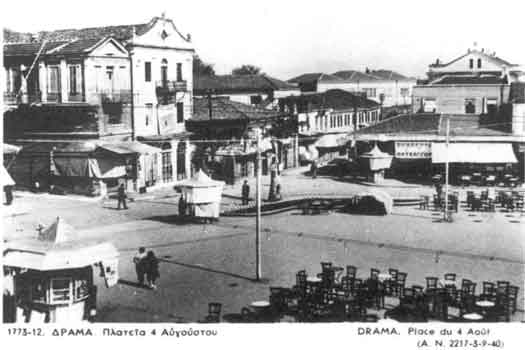
Drama Plateia 4th August around 1940 [Source]
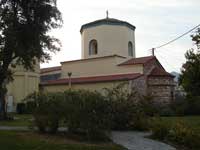
Church of Agia Sofia, Drama
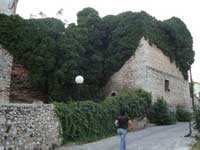
Part of the town's Byzantine wall
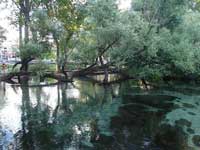
Source of Agia Varvara
Population
Year Town Municipal district Municipality
1981 37,118 - -
1991 37,604 - 47,925
2001 42,501 43,485 55,632
Corporation with other cities
Serbia Kragujevac, Serbia
GermanyLauf an der Pegnitz, Germany
Culture
Since 1978, Drama hosts a Short Film Festival. In 1987, the festival was recognized nationally. It which was included in 1996 in the National Cultural Network of Cities by the Greek Ministry of Culture.[8]
Museums
Archaeological Museum
Two exceptional works of art in copperThe Archaeological Museum of Drama covers human presence in the prefecture of Drama from the mid Paleolithic Period (50,000 years before present) with traces of life from Paleolithic hunts in the caves of the source of the Angitis, up to modern times (1913).
The exhibition space consists of three main halls. In the first archaeological finds from the cave of Maara give witness to the presence of nomadic hunters in the area from the mid Palaeolithic period, while other finds show us about the life of settled farmers and animal rearers from Neolithic villages and the passage of the Copper Age in the city of Drama and the village of Sitagri. The reproduction of a Neolithic house with finds which describe the activities of Neolithic man and his daily activities is the main centre of interest for visitors of all ages.
Bust of Dionysius, found in the area of Kali Vrysi. The same hall continues the journey through time to the Iron Age and later years where the main element was the worship of Dionysius at the city of Drama itself and at Kali Vrysi and other areas of the prefecture. In the second hall architectural sculptures, pottery and coins confirm that life continued in the city and throughout the whole prefecture during early Christian, Byzantine and post-Byzantine years.
The visitor is taken through modem recent history by a photographic exhibition relating to the city of Drama, the towns of the prefecture and the mountain villages. The exhibition covers the period from the beginning of Turkish occupation up to the middle of the 19th century. In the third hall which is roofed with an atrium, the visitor can admire sculptures arranged into three thematic groups. The first includes architectural sculptures dating from ancient times up to Turkish occupation. The second contains votive monuments connected with the worship of various gods in the Greco-Roman pantheon as well as local deities, with particular reference to Dionysius while the third group of sculptures focuses on funerary monuments from Hellenistic and Roman times.
Ecclesiastical Museum
The history of the Christian Church in Drama began during the Byzantine period and underwent difficult and troubled times. From the 14th century when the city was captured by the Ottomans until the 20th century with successive foreign occupations, the Greek Orthodox Church in Drama struggled without end, fed by the blood of many faithful, martyrs to the faith and to the Hellenic ideal and provided succor to its followers through difficult periods.
The collection of icons dating from Byzantine times to the 20th century forms the basic core of the museum's exhibits. The Museum of the Cathedral of Drama, founded during the reign of the honourable Bishop Dionysius 1st, is now housed in a recently restored five-storey wing of the Bishop of Drama's palace on Venizelou St. In the spacious and well-attended halls, ecclesiastical treasures of priceless spiritual and artistic value are on exhibition. The Icons of the Virgin Ηοdegetria and the Blessing Lord from the 13th century, icons from the 17th century and particularly from the 19th century decorate and sanctify the place. Moreover, the episcopal canonicals, holy vessels and their covers, many from the 19th century, relics of Chrysostomos of Drama and Smyrni, constitute the most important exhibits in the museum.
Many of the exhibits are relics brought by refugees from Asia Minor and Pontus in 1922 from the churches of their ancient homes to their new home, valuable reminders of who they were and where they came from. Organized groups of pilgrims and visitors to the city are advised to contact the office of the Diocese of Drama before visiting the museum to make arrangements.
Sport teams
Doxa Dramas - football team
Pandramaikos FC - football team
KAOD (basketball club) - Basketball team
PAOP Neas Amissou - football team
Notable people
Mahmud Dramali Pasha (1780–1822) - Ottoman General during the Greek Independence War
Ibrahim Pasha of Egypt (1789–1848) ruler of Egypt in 1848 (Son of Muhammad Ali of Egypt)
Basilis C. Xanthopoulos (1951–1990) Theoretical Physicist
Koulis Stoligkas (1910–1984), actor
Ioannis Fetfatzidis, footballer.
Nikos Sergianopoulos (1952–2008), Television and stage Actor
Giannis Papazisis - actor
Natassa Theodoridou - singer
Tania Tsanaklidou - singer
Petros Gaitanos - singer
Paschalis Arvanitidis - singer
Yesari Asım Arsoy(1900–1992)Classical Turkish Music Composer- singer
See also
List of communities of the Drama prefecture
References
Notes
^ "Εκδηλώσεις για απελευθέρωση Δράμας" ("Events for Liberated Drama") Otenet Portal, in Greek, accessed 8 July 2009
^ see e.g. Xanthippi Kotzageorgi-Zymari and Tassos Hadjianastassiou, "Memories of the Bulgarian Occupation of Eastern Macedonia: Three Generations.", in: Marc Mazower (ed.), After the War was Over: reconstructing the family, nation, and state in Greece, 1943-1960. Princeton University Press, 2000, ISBN 9780691058429 p. 273-292, also in the introduction, p. 4
^ "יהודי בולגריה - כפשע בינם לבין המוות (Bulgaria's Jews - avoiding the death)" (in Hebrew). Yad Vashem Memorial. Retrieved 8 August 2011.
^ (in Hebrew):Bar-Zohar, Michael, The trains went out empty, Hed-Artzi, Or-Yhuda, Israel, 1999
^ [1]
^ Αγγελιοφόρος, September 24, 2006
^ Kallikratis law Greece Ministry of Interior (Greek)
^ "Short Film Festival in Drama - History". Retrieved 8 August 2011.
Bibliography
Gaydarska, B. "Prehistoric Drama and its regional context," in Stoyanov, T., Angelova, S. & Lozanov (eds), Stephanos Archaeologicos in honorem Professoris Ludmilli Getov, Vol. I (Sofia: Sofia University Press, 2005), 116 – 133.
| Municipal unit Drama |
|---|
| Municipal Community Drama |
| Ampelakia (Αμπελάκια, τα) |
| Drama (Δράμα Μακεδονίας, η) |
| Νέα Σεβάστεια, η |
| Taxiarches (Ταξιάρχαι, οι) |
| Τιμόθεος, ο |
| Municipal Community Xiropotamos |
| Μεταμόρφωσις Σωτήρος, η |
| Xiropotamos (Ξηροπόταμος, ο) |
| Municipal Community Choristi |
| Choristi (Χωριστή, η) |
| Community Kallifytos |
| Kallifytos (Καλλίφυτος, η) |
| Πανόραμα, το |
| Community Kalos Agros |
| Kalos Agros (Καλός Αγρός, ο) |
| Community Koudounia |
| Koudounia (Κουδούνια, τα) |
| Community Livadero |
| Dendrakia (Δενδράκια, τα) |
| Λιβαδερόν, το |
| Χαράδρα, η |
| Community Makryplagio |
| Makryplagio (Μακρυπλάγιο, το) |
| Πολύκαρπος, ο |
| Community Mavrovatos |
| Mavrovatos (Μαυρόβατος, ο) |
| Community Mikrochori |
| Mikrochori (Μικροχώρι, το) |
| Community Monastiraki |
| Βαθύλακκος, ο |
| Monastiraki (Μοναστηράκι, το) |
| Community Mylopotamos |
| Mylopotamos (Μυλοπόταμος, ο) |
| Community Nikotsaras |
| Nikotsaras (Νικοτσάρας, ο) |
| Municipal unit Sidironero |
| Community Sidironero |
| Kallikarpo (Καλλίκαρπο, το) |
| Oropedio (Οροπέδιο, το) |
| Pappades (Παππάδες, οι) |
| Sidironero (Σιδηρόνερο, το) |
| Community Skaloti |
| Skaloti (Σκαλωτή, η) |
|
Municipalities and communities of the Drama Prefecture Doxato | Drama | Kalampaki | Kato Nevrokopi | Nikiforos | Paranesti | Prosotsani | Sitagroi |
| Ancient Greece
Science, Technology , Medicine , Warfare, , Biographies , Life , Cities/Places/Maps , Arts , Literature , Philosophy ,Olympics, Mythology , History , Images Medieval Greece / Byzantine Empire Science, Technology, Arts, , Warfare , Literature, Biographies, Icons, History Modern Greece Cities, Islands, Regions, Fauna/Flora ,Biographies , History , Warfare, Science/Technology, Literature, Music , Arts , Film/Actors , Sport , Fashion --- |
Retrieved from "http://en.wikipedia.org/"
All text is available under the terms of the GNU Free Documentation License


